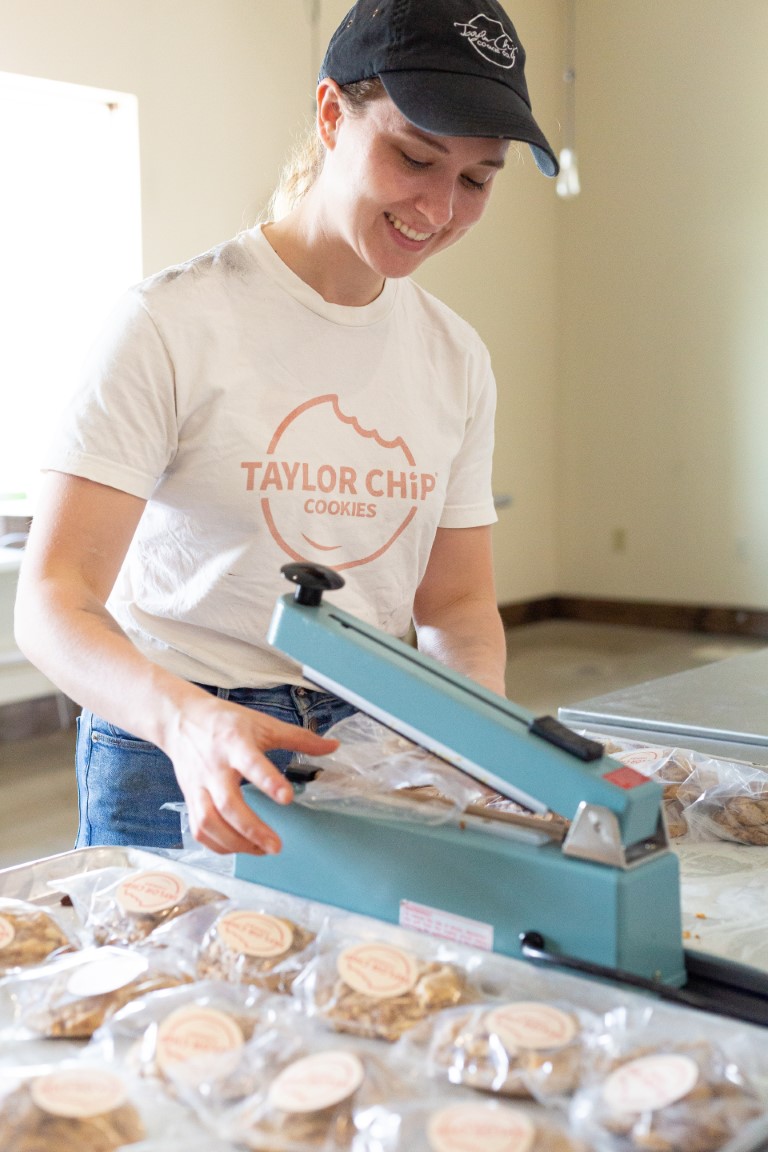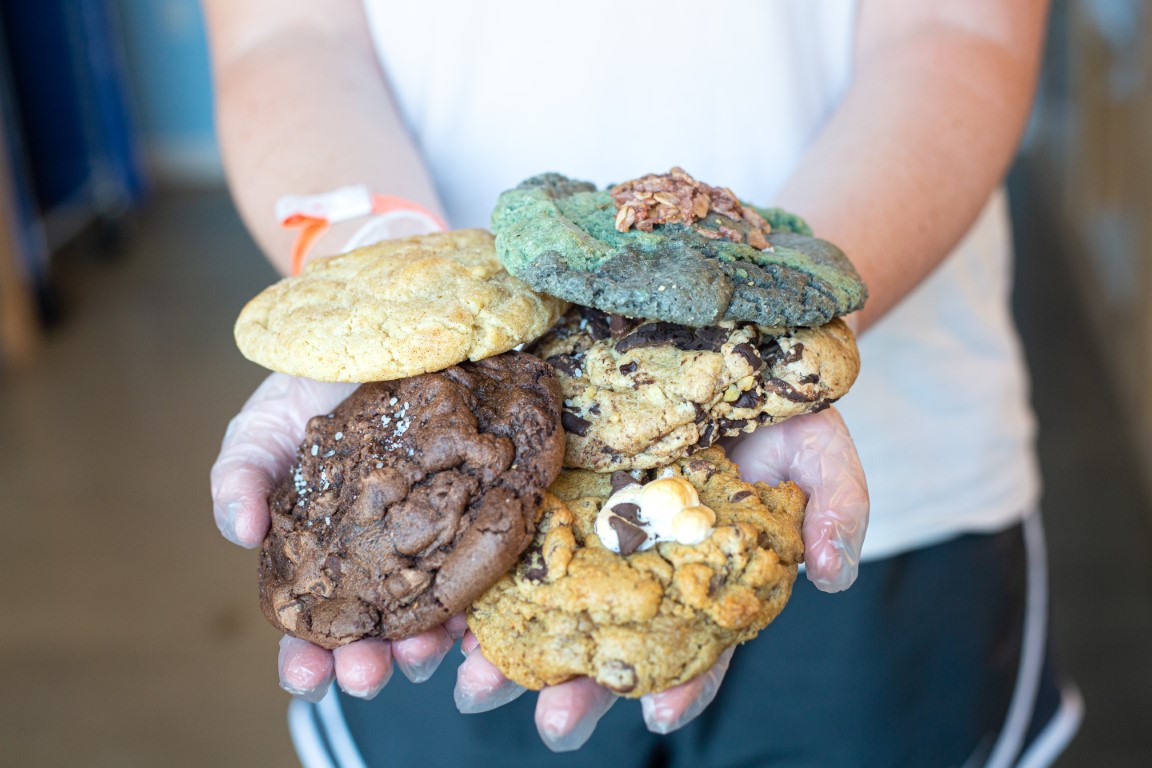To thaw frozen cookies effectively, place them in an airtight container or arrange them on parchment paper at room temperature for 1-2 hours, avoiding direct sunlight or heat sources to maintain texture and flavor. For a quicker method, use your microwave on the defrost setting in short 10-15 second intervals, checking frequently. Alternatively, place cookies in a preheated oven at 300°F for 10-15 minutes on a parchment-lined baking sheet for even thawing. Gradual thawing in the refrigerator overnight can also maintain quality. Each method has unique benefits, and understanding their nuances can greatly enhance your thawing results.
Key Takeaways
- Thaw cookies at room temperature on parchment paper for 1-2 hours to maintain texture and flavor.
- Use the microwave on medium setting, checking every 10-15 seconds to avoid overcooking.
- Preheat oven to 300°F and thaw cookies on a parchment-lined sheet for 10-15 minutes.
- Thaw cookies in the refrigerator overnight for gradual and quality texture preservation.
- Utilize an air fryer or toaster oven for quick, energy-efficient thawing and warming.
The Science of Freezing Cookies
When you freeze cookies, the process affects their texture and overall quality. As water in the dough freezes, it forms ice crystals, which can alter the structure of the cookie, making it either softer or, in some cases, more brittle once thawed. Understanding these changes helps you manage expectations and guarantee your cookies taste just as good after freezing.
Impact on Texture and Quality
Freezing cookies can greatly impact their texture and quality due to the science behind how water and fats behave at low temperatures. When you freeze cookies, the water content inside them turns into ice crystals, which can expand and disrupt the cookie's structure. This process can lead to changes in texture and quality, making your frozen cookies less enjoyable compared to fresh-baked cookies.
During the thawing process, these ice crystals melt back into water, which can make the cookies soggy if not handled properly. To maintain the best texture and quality, it's essential to manage the defrosting process carefully. Allow your cookies to thaw at room temperature, which helps minimize moisture loss and prevents them from becoming too dry or too wet. Avoid using a microwave for defrosting, as it can unevenly heat the cookies, causing some parts to become overly soft while others remain hard.
Additionally, the fats in cookies can become rancid over time when frozen, especially if not stored in airtight containers. This can affect the overall flavor and quality. By understanding these factors, you can better preserve the delightful texture and taste of your cookies.

Choose Your Own Delightfully Perfect Cookies.
With almost 30 flavors to choose from, you can make your box as unique as you are.
Effective Thawing Methods
When it comes to thawing your frozen cookies, you have several effective methods to choose from. You can let them thaw at room temperature, use the microwave for a quicker option, or employ the oven for a more controlled approach. Each method has its own advantages and considerations, ensuring your cookies are ready to enjoy in no time.
Room Temperature Thawing
Thawing frozen cookies at room temperature is a straightforward and effective method that maintains their texture and flavor. To start, remove the frozen cookies from the freezer and place them on a clean, flat surface. For best results, arrange the cookies on a sheet of parchment paper to prevent sticking and guarantee even thawing. It's important to allow enough space between each cookie to promote proper airflow.
Using an airtight container is vital during this process. If you don't have one, cover the cookies lightly with plastic wrap or aluminum foil to avoid any exposure to air, which can lead to dryness or staleness. Allow the cookies to sit at room temperature, making sure they're not placed in direct sunlight or near heat sources, as this can alter their texture.
- Use parchment paper: Prevents sticking and guarantees even thawing.
- Airtight container: Maintains freshness and prevents exposure to air.
- Avoid direct heat: Keeps cookies from becoming too dry or altering texture.
Typically, cookies will thaw completely within one to two hours, depending on their size and thickness. Once thawed, they're ready to enjoy, retaining the same delicious taste and texture as when they were first baked.
Microwave Thawing
Microwave thawing offers a quick and efficient way to bring your frozen cookies back to their fresh, ready-to-eat state. To start, place your frozen cookie on a microwave-safe plate. Confirm the cookie is not overlapping with others, as this helps evenly distribute the heat. If you have a large batch of already-baked cookies, you may need to thaw them in multiple rounds.
Set your microwave to a medium or defrost setting. High settings can cause the cookies to become too soft or even cook further, which you want to avoid. Microwave the cookie for 10-15 seconds initially. After the first interval, check the cookie. If it's still frozen, continue microwaving in 5-10 second increments until fully thawed. Be cautious not to overdo it; microwaving for too long can make the cookie rubbery or dry.
Once thawed, let the cookie sit for a minute to allow the heat to distribute evenly. If you're dealing with a batch of cookies, consider transferring them to a baking sheet after microwaving to cool down uniformly. This method confirms that you thaw frozen cookies quickly, making them ready to enjoy in just a few minutes.
Oven Thawing
For those looking for a more even and controlled thawing process, oven thawing is an excellent method. To thaw frozen cookies in the oven, begin by preheating your oven to a low temperature, around 300°F (150°C). This gentle heat guarantees that the cookies thaw without overcooking.
Place the frozen cookies on a parchment-lined baking sheet. The parchment prevents the cookies from sticking and makes cleanup easy. Arrange the cookies in a single layer, making sure they aren't touching. This encourages even thawing and prevents them from merging together.
For a successful thaw, it's important to monitor the baking time closely. Typically, frozen cookies need about 10-15 minutes in the oven. Keep an eye on them to avoid any overly crispy edges. Remember, the goal is to thaw, not bake them further.
Consider these tips for ideal results:
- Check frequently: Monitor the cookies every few minutes to prevent over-thawing.
- Use a thermometer: Verify the oven temperature stays consistent.
- Follow safety guidelines: Be mindful of food safety concerns by not leaving the cookies out for too long post-thawing.
Factors Affecting Thawing Quality
When thawing frozen cookies, several factors can greatly impact the final quality. The composition of the cookie, including ingredients and baking methods, plays an essential role, while the temperature and duration of thawing also affect the outcome. Additionally, both flavor and texture may change during the process, so understanding these elements helps maintain the cookies' original appeal.
Cookie Composition
The composition of your cookies plays an essential role in how well they thaw. Whether you have chocolate chip, oatmeal, or sugar cookies, each type reacts differently when frozen and thawed. Ingredients like butter, sugar, and flour interact in unique ways under cold conditions, which can affect the texture and flavor of your frozen cookies once they're brought back to room temperature.
For ideal results in thawing cookies, consider the following factors in your cookie composition:
- Fat Content: Cookies with a higher fat content, like butter or shortening, tend to maintain their texture better after thawing.
- Moisture Level: Cookies that have a higher moisture content, such as those with added fruits or syrups, may become soggy if not stored properly.
- Add-ins: Ingredients like nuts, chocolate chips, or dried fruits can affect the thawing process, as they may thaw at different rates compared to the dough.
Ensuring your cookies are freezer safe is essential. Store them in an airtight storage container to prevent freezer burn and preserve their quality. When you're ready for thawing cookies, these steps will help maintain their delicious taste and texture, making your frozen cookies as enjoyable as freshly baked ones.
Temperature and Time
Understanding your cookie composition is just the start; now let's focus on temperature and time, two essential factors that impact how well your cookies thaw. When you're thawing frozen cookies, the temperature must be controlled carefully. If you rush the process by using high temperatures, you risk uneven thawing and potential texture and flavor changes. Instead, thaw your cookies at room temperature for best results. This method guarantees that your cookies gradually regain their original moisture and texture, mimicking the qualities of fresh cookies.
Time is equally important in the thawing process. Depending on the size and type of cookie, the thawing time can vary. Generally, smaller cookies might take about 30 minutes to an hour to thaw at room temperature, while larger or denser cookies could require a couple of hours. Patience is key; allow enough time for the cookies to thaw naturally. Rushing this process by using a microwave or oven can lead to dry or soggy cookies, which are far from ideal.
Flavor and Texture Changes
Thawing frozen cookies can impact their flavor and texture, making it crucial to understand the variables that affect thawing quality. When you thaw frozen cookie dough or baked cookies, several factors come into play that can alter their taste and consistency. One key factor is the moisture content. If cookies lose too much moisture during freezing, they can become dry and crumbly upon thawing. On the other hand, retaining too much moisture can make them soggy.
Proper storage in freezer containers is essential to maintain ideal flavor and texture. Airtight containers prevent moisture loss and protect cookies from absorbing unwanted odors from the freezer, preserving their original taste. Additionally, the type of cookie affects how it reacts to being frozen and thawed. Soft cookies, for instance, might become overly soft, while crispy cookies could lose their crunch.
Consider these points for better thawing results:
- Moisture Management: Properly balance moisture levels to avoid dry or soggy cookies.
- Freezer Containers: Use airtight containers to preserve flavor and texture.
- Cookie Type: Adjust thawing methods based on whether cookies are soft or crispy.
Best Practices and Common Mistakes
When thawing frozen cookies, you must start with proper storage techniques to maintain their quality. Always use airtight containers or heavy-duty freezer bags to prevent freezer burn, and make sure to label them with the date of freezing. Avoid refreezing thawed cookies, as this can lead to a loss of texture and flavor.
Proper Storage Techniques
Proper storage techniques are essential for maintaining the freshness and quality of your cookies. To start, you should guarantee that your cookies are completely cooled before storing them. Use freezer bags, plastic wrap, or airtight freezer containers to keep your cookies fresh. By wrapping each cookie individually in plastic wrap, you prevent them from sticking together and preserve their texture. For frozen cookie dough balls, place them on a baking sheet to freeze initially, then transfer them to freezer bags for long-term storage.
Here are some best practices to follow:
- Use quality materials: Invest in sturdy freezer bags and airtight containers to protect against freezer burn.
- Label and date: Always label your containers with the type of cookie and the date they were frozen to keep track of freshness.
- Portion control: Store cookies in small batches to make thawing cookies easier and to prevent refreezing large amounts.
Common mistakes include not using airtight containers, which can lead to moisture loss and freezer burn, and overcrowding cookies in a single container, causing them to stick together. By following these proper storage techniques, you'll guarantee your cookies remain delicious and ready to enjoy whenever you decide to thaw them.
Avoiding Refreezing
One essential aspect of maintaining the quality of your frozen cookies is to avoid refreezing them. When thawing cookies, guarantee you only defrost the amount you plan to consume within a short period. Refreezing can compromise the texture and taste, leading to a less enjoyable treat.
To avoid refreezing, use an airtight container for storage. This minimizes exposure to air, helping to preserve the cookies' freshness and prevent freezer burn. When you're ready to thaw, transfer the desired number of cookies to a plate and leave them at room temperature or in the refrigerator overnight. Thawing cookies slowly helps maintain their original texture and flavor.
Food safety is another significant factor. Refreezing can increase the risk of bacterial growth, especially if the cookies have thawed in warmer temperatures. Once thawed, consume your cookies within a couple of days to guarantee they remain safe and delicious.
Innovative Thawing Technologies
To thaw your frozen cookies more effectively, consider using innovative technologies like ultrasound-assisted thawing and high-voltage electric field thawing. These methods can markedly reduce thawing time while maintaining the quality of your cookies. By utilizing these advanced techniques, you can guarantee your cookies are ready to enjoy much faster than traditional methods.
Ultrasound-Assisted Thawing
Imagine a high-tech kitchen gadget that speeds up the thawing process while keeping your cookies' texture and flavor intact. This is what ultrasound-assisted thawing offers. By using sound waves, this method efficiently transfers energy to your frozen cookies, ensuring they thaw quickly and evenly.
Ultrasound-assisted thawing isn't just about speed; it's also about preserving the quality of your cookie dough. When you use this technology, the sound waves penetrate the frozen food, causing rapid vibration of water molecules. This results in a more consistent thaw, preventing those unwanted soggy or dry spots that sometimes occur with traditional methods.
Here's what makes ultrasound-assisted thawing stand out in food prep:
- Speed: Thawing frozen cookies in record time, allowing you to enjoy them faster.
- Uniformity: Ensuring even thawing to maintain the texture and flavor of your cookie dough.
- Quality: Reducing the risk of moisture loss and preserving the integrity of your cookies.
Incorporating ultrasound-assisted thawing into your kitchen routine can transform how you approach preparing frozen cookies. This innovative technology not only saves time but also enhances the overall quality of your baked goods, making it a priceless tool for any home baker.
High-Voltage Electric Field Thawing
While traditional thawing methods can be time-consuming and inconsistent, high-voltage electric field (HVEF) thawing offers an innovative solution. This advanced technology uses electrical fields to speed up the thawing process, making it ideal for frozen foods like cookies. By applying a high-voltage electric field, the water molecules within the frozen cookies vibrate more vigorously, causing the ice to melt faster and more uniformly.
HVEF thawing is particularly advantageous for food prep because it minimizes the risk of uneven thawing, which can lead to undesirable textures or even partial cooking. Unlike microwave thawing, which can sometimes result in hot spots, HVEF guarantees a more consistent temperature throughout the cookies. This method also helps preserve the quality and taste of the frozen cookies, making them taste as fresh as when they were first baked.
To use HVEF thawing, you'll need specialized equipment designed to generate the necessary electric fields. While this technology is still emerging and may not be widely accessible for home kitchens yet, it's gaining traction in commercial food prep environments. As HVEF thawing technology becomes more common, it promises to revolutionize how we handle frozen foods.
Environmental Considerations
When thawing your frozen cookies, consider using sustainable and energy-efficient methods to reduce your environmental impact. Opt for natural thawing by leaving them at room temperature, which uses no additional energy. Alternatively, you can use an energy-efficient appliance like a microwave with an eco-mode setting.
Sustainable and Energy-Efficient Methods
Thawing frozen cookies can be done in ways that are both sustainable and energy-efficient, minimizing your environmental footprint. By focusing on sustainable methods, you not only conserve energy but also reduce waste and encourage eco-friendly practices. To thaw frozen cookies effectively, consider these approaches:
- Countertop Thawing: This method requires no energy at all. Simply place the frozen cookies on a plate and let them thaw naturally at room temperature for a few hours. This allows you to utilize the ambient temperature, making it the most sustainable option.
- Refrigerator Thawing: While not as quick as using a microwave, this method is more energy-efficient. Place the cookies in the refrigerator the night before you plan to eat them. The gradual thawing process helps maintain the cookies' texture and flavor.
- Air Fryer or Toaster Oven: If you must use an appliance, opt for an air fryer or toaster oven instead of a conventional oven. These smaller appliances use less energy and can thaw and warm your cookies in a fraction of the time.
Experimenting With Thawing Techniques
When you're experimenting with different thawing techniques, it's crucial to document your results meticulously. Keep track of how each method affects the texture, flavor, and overall quality of the cookies, and consider variables like time and temperature. Sharing your findings with others can help refine the best practices and contribute to a broader understanding of effective thawing methods.
Documenting and Sharing Results
As you explore experimenting with different thawing techniques for frozen cookies, it's crucial to document and share your results meticulously. This practice guarantees that you can replicate successful methods and avoid ineffective ones. Start by noting the type of cookie and the specific thawing method used, whether it's room temperature, microwave, or oven. Record the time taken to thaw and any changes in texture or taste.
For a systematic approach, consider the following:
- Consistency: Use a container with layers to keep cookies separate and prevent sticking during food prep.
- Timing: Record how long each method takes to thaw the cookies completely.
- Quality: Compare the fresh-baked cookie taste to the thawed cookies to evaluate each method's effectiveness.
Sharing your findings can be equally beneficial. Create a simple spreadsheet or use a digital note-taking app to log each experiment's details. Share your results with friends or online baking communities to get feedback and uncover new techniques. Documenting and sharing your results not only helps in perfecting your cookie-thawing skills but also contributes significant observations to others who share your interest in baking and food prep. This collaborative effort can lead to uncovering the best methods for achieving that perfect, fresh-baked cookie taste from frozen cookies.
Our Journey to Cookie Perfection: Why Trust Our Thawing Insights
At Taylor Chip, our expertise in cookie-making isn't just about following recipes – it's a passion that has evolved through years of dedicated experimentation and refinement. Since 2015, Sara and Dougie Taylor have been on a relentless quest to create the perfect cookie, a journey that has given us unparalleled insights into every aspect of cookie craftsmanship, including the crucial process of thawing frozen cookies.
Our obsession with perfecting cookies led us to explore every nuance of baking, from ingredient selection to storage techniques. This hands-on experience has provided us with a deep understanding of how different cookie compositions react to freezing and thawing. We've spent countless hours testing various methods to ensure that our cookies maintain their fresh-baked taste and texture, even after being frozen. This expertise allows us to offer you tried-and-true advice on how to thaw your frozen cookies effectively, preserving the quality we've worked so hard to achieve.
By trusting our insights on thawing techniques, you're benefiting from years of passionate experimentation and real-world experience. We've faced and overcome the challenges of maintaining cookie quality through the freezing and thawing process, and we're excited to share our knowledge with you. Whether you're a home baker or simply someone who enjoys a perfect cookie, our expertise ensures that you'll be able to enjoy bakery-fresh taste, even when working with frozen cookies.
Frequently Asked Questions
How Long Can You Store Cookies in the Freezer Before Thawing?
You're probably wondering how long you can store cookies in the freezer before thawing. Typically, you can keep them for up to three months. Just make sure they're stored in an airtight container to maintain freshness.
Can You Refreeze Cookies After They Have Been Thawed?
You shouldn't refreeze cookies after thawing. The texture and taste can degrade, and bacteria might grow. It's best to thaw only what you'll eat soon. If you've thawed too many, consider sharing or storing them in the fridge.
Are There Specific Types of Cookies That Freeze Better Than Others?
You'll find that sturdy cookies like chocolate chip and oatmeal raisin freeze better than delicate ones like macarons. Their texture holds up well, and they're less likely to crumble or become soggy after thawing.
What Packaging Is Best for Freezing Cookies?
For the best packaging, use airtight containers or heavy-duty freezer bags. Make sure to remove as much air as possible. You can also layer cookies with parchment paper to prevent sticking and preserve their freshness.
Can You Thaw Cookies in a Microwave?
Yes, you can thaw cookies in a microwave. Just place them on a microwave-safe plate and heat for 10-15 seconds at a time until they're thawed. Be careful not to overheat, or they might get too soft.
Conclusion
In summary, thawing frozen cookies effectively requires understanding the science behind freezing, choosing the right thawing methods, and considering factors that affect quality. By adhering to best practices and avoiding common mistakes, you can guarantee superior taste and texture. Exploring innovative technologies and environmental impacts can further refine your approach. Experimenting with various techniques will help you identify the most effective methods, ensuring your cookies are enjoyed as intended.










